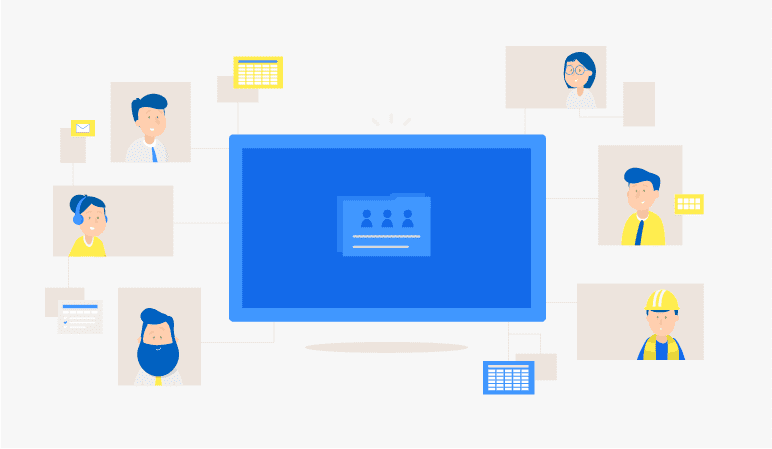Everything you need to know about workforce planning
Explore the essential aspects of workforce planning in this article, where we provide valuable insights and actionable advice to enhance your organization’s staffing strategies effectively.

Workforce planning is a continual process used to align the needs and priorities of the organization with those of its workforce. It requires strategic insight and in‑depth knowledge of the primary operational processes.
But why is workforce planning so important? And how should you tackle this way of working in your daily operations? These are the questions we’ll be answering in this article.
What is workforce planning?Copied
Before we discuss the how and why of workforce planning, let’s take a closer look at exactly what it is.
Definition
According to Wikipedia, workforce planning is “a continual process used to align the needs and priorities of the organization with those of its workforce to ensure it can meet its legislative, regulatory, service and production requirements, and organizational objectives.” It’s evidence‑based and founded on an analytical approach to operational processes and workflows.
Proper workforce planning demands close cooperation between a company’s Human Resources and Finance departments. Not surprisingly, because the process focuses on various aspects of both current and future characteristics of your workforce, for example:
- scope
- diversity
- skills present vs. required (skills gap)
- collective workforce expertise/experience
But what is workforce planning?
The Wikipedia definition above may sound a little academic and theoretical. A simpler definition is the right people in the right place at the right time. This means having enough people who can perform a specific task without being either overstaffed or understaffed. In other words, your workforce is in perfect balance with your company’s needs.
What’s its purpose?
Why is workforce planning becoming increasingly important in the modern‑day labor market? Experts have pinpointed four main reasons.
- Demographic changes, such as aging populations, are already resulting in shortages of much‑needed skills, challenges relating to retraining, and large numbers of employees leaving the labor market.
- Increasing international competition is forcing companies to work more cost‑effectively and efficiently, and hence, a smarter, more productive workforce is needed.
- Talent management is playing an ever‑more prominent role. It’s giving companies a more competitive edge and ensuring that talented individuals are streamlined to replace older employees when they retire or leave.
- The current marketplace is demanding ever‑greater and more rapid innovation, especially in terms of technology. Without proper workforce planning, you risk being left behind.
What’s the ultimate goal of workforce planning? To mold a workforce that can satisfy all business requirements in terms of scope, mix, economics, and flexibility. Let’s take a look at these four factors in more detail.
- Scope relates to the number of employees and job openings. If you have a lot of job openings, it means certain core skills are missing and/or not all skills are optimally covered.
- Mix refers to having the skills and competences in‑house that you’ll need now and in the future.
- Economics focuses on finding the right balance between labor costs and operational requirements. Excessive labor costs are a drain on any company’s resources, but underspending is equally damaging with insufficient staffing levels or skills to tackle projects or seize new opportunities.
- Flexibility means your workforce’s ability to respond rapidly and capitalize on changing market conditions.
What are the benefits?Copied
Getting serious about workforce planning has a lot of benefits. Below, we’ll discuss some of the foremost advantages.
- Workforce planning helps make it easier to optimize your operating costs. Armed with a clearer picture of the skills present and those required, you’re better positioned to make the most of your organization’s skill sets. This results, first and foremost, in higher productivity. It also helps you fine‑tune your recruitment and selection efforts in alignment with your company’s current requirements.
- Workforce planning helps you tackle staff turnover more effectively, because you’re better positioned to respond when key players retire or leave the company.
- Are there skills your organization is still lacking within its existing workforce? Workforce planning pinpoints the problem areas and helps you close any emerging skills gaps quickly and effortlessly.
- Being successful in business depends on continually improving your critical KPIs. This is far simpler when you have all the information at your disposal that workforce planning provides.
- The way in which younger generations learn, or prefer to learn, differs from traditional, classroom‑style methods – they’re more responsive to on‑the‑job training. Workforce planning allows you to create the right training program for each skill. This enables training programs to be tailored to both your staff’s and your organizational needs and objectives.

Step‑by‑step strategic workforce planningCopied
How can you strategically implement workforce planning in practice? And what does your company need to do to get the most out of this way of working? Let’s answer these questions step by step.
1. Set clear operational objectives
Workforce planning focuses on achieving current and future operational objectives. That’s why it’s important to set clear goals for both the short and the long term. What do you want to achieve now and in the future? What resources do I need to reach these goals?
Formulating clear answers to these questions makes workforce planning more concrete and allows you to translate these operational objectives into recruitment strategies based on specific skills and competences. What’s more, it provides greater clarity and alignment for all concerned.
2. Analyze your current workforce
This second step involves analyzing your current workforce. Which skills and competences are well represented within your organization? Do you have a sufficient spread? Are important skills missing or lacking? Analyzing your workforce is important from both a quantitative and qualitative point of view.
- Qualitative refers to your workforce’s current performance level and its future potential. Do your staff already have the skills and qualities required to be competitive today? And what about their future potential? Is your current workforce able to respond to changes and new market developments, or are there other skills your current workforce still need to acquire? A qualitative workforce analysis opens the door to targeted talent management.
- Quantitative refers to the number of employees in each department or at each layer of the organization. Are these layers – senior and middle management and production and support personnel – adequately staffed?
3. Spot emerging skills gaps
Once you’ve carefully mapped out your current workforce, it’s then possible to plan ahead and anticipate imminent skills gaps. Skills gaps emerge as staff leave the company or reach retirement age.
A thorough analysis of your workforce and organizational requirements can prevent a skills gap from forming. How should you tackle recruitment and selection? Should you operate taking more of a project‑based approach? Is training existing staff the best solution? Or does a combination of these three strategies provide a higher chance of success? Proper workforce planning can give you answers to these all‑important questions.
4. Prepare for multiple scenarios
The future isn’t etched in stone. We can make all the predictions we want about the future labor market, but it wouldn’t be the first time that predictions proved worthless. That’s why it’s vital that you plan for multiple scenarios.
For example, if you anticipate that a lot of the repetitive tasks within your organization will be automated over the next few years, then it’s worthwhile considering now how to redeploy those employees who currently carry out these particular tasks.
However, it’s impossible to predict just how rapidly technologies such as robotic automation and artificial intelligence will make their mark. For this reason, you should plan your future workforce requirements taking various scenarios into account, whereby these technologies are adopted at varying rates.
5. Monitor and adjust
Even once you’ve created and implemented workforce planning, you’re still not done! On the contrary, the business world, the labor market, technology, and customers’ needs and requirements are in such a state of flux that constant analysis, monitoring, and adjustment are essential if workforce planning is to succeed. Fortunately, statistics, analytics, and big data can be used to help you in this respect.

Practical tipsCopied
By familiarizing yourself with the benefits of workforce planning and following the steps outlined above, it’ll become much easier to identify which skills exist within your organization, or are missing. We’ve provided some additional tips below to help you on your way.
Trend analysis
To determine which skill sets will be needed within a given sector or industry, it’s vital you follow the latest trends and developments. Which skills are your competitors and partners looking for? What growth strategies are these companies adopting? And which key national and international trends are having a major impact on your sector?
Recruit people with highly sought‑after skills
The better you know your sector and the market’s needs and requirements, the easier it will become to identify which skills are important and highly sought‑after. For example, tech skills are important in this modern age and, looking ahead, it would be advisable to invest in staff with knowledge of data analytics, machine learning, artificial intelligence, and software development.
Look further afield
A characteristic of the modern‑day business world is a blurring of the traditional boundaries between sectors and disciplines. Take, for example, the automotive industry that’s using state‑of‑the‑art technologies such as artificial intelligence (AI) and geographic information systems (GIS), or health care that’s embracing modern IT technologies such as e‑health. It’s worthwhile looking further afield every so often to see what’s happening in other industries and with high‑value products and services.
Use quality software
Workforce planning stands or falls based on the strength and quality of the software you’re using. Good software makes planning much easier and allows users to create more accurate models and predictions. A prime example of such workforce planning software is AG5’s software. Its skills management software replaces all your spreadsheets with information about your employees’ skills and competences and stores them centrally in a cloud‑based environment. Authorized individuals, teams, or departments can then access and update this information – clearly, concisely, and conveniently.
Copied
Start planning your workforceCopied
Workforce planning can be used strategically to get to grips with the skills and competences present, lacking, or missing within your organization. It also serves as a springboard for safeguarding your organization’s future.
It’s important that you tackle workforce planning step by step and keep an eye on market developments and technological advances inside and outside your industry. And make sure you use software that helps you analyze all your data effectively and efficiently.
AG5’s software is one of several tools that can help you tackle workforce planning in this way. Feel free to get in touch or schedule a live demo for additional information.

